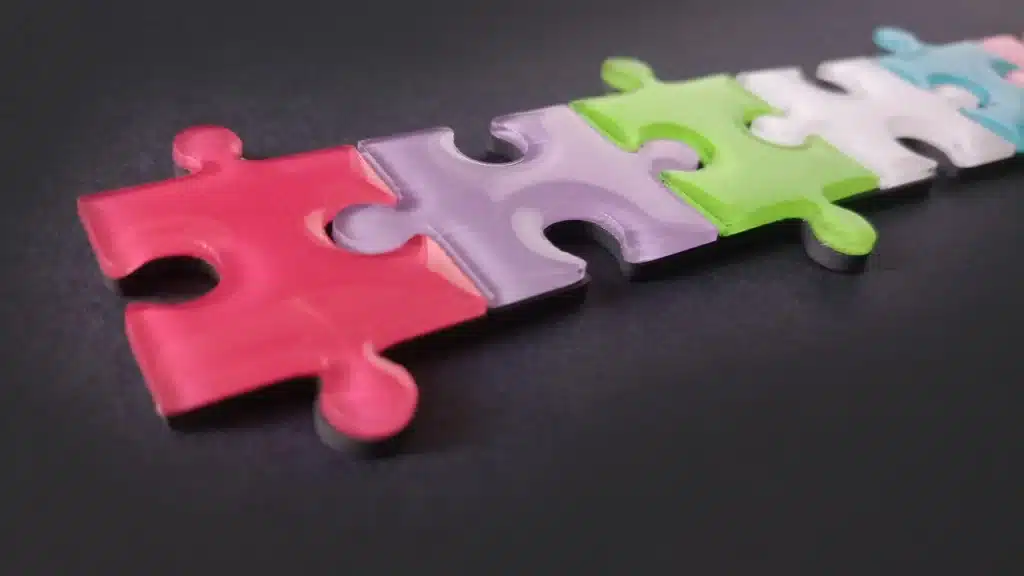Last Updated on March 5, 2024 by JigsawPuzzleGuru
Table of Contents
Enhancing Focus Through Structured Play
Jigsaw puzzles have long been more than just a pastime; they’re a tool for educational development and mental stimulation. It is believed that jigsaw puzzles for ADHD are helpful. Notably, individuals with Attention Deficit Hyperactivity Disorder (ADHD) may benefit from the task of piecing together a jigsaw puzzle. The activity can serve as a therapeutic exercise that promotes improved focus and concentration—skills that are often challenging for those with ADHD.
The process of assembling a jigsaw puzzle requires patience and an analytical approach, as one must identify patterns and sort pieces based on subtle differences in shape and color. For someone with ADHD, this can translate into a calming exercise that enables the practice of sustained mental effort and attention to detail. Puzzles offer a unique opportunity to strengthen these abilities in a low-pressure environment.
Furthermore, the tangible rewards of jigsaw puzzles—seeing a coherent image emerge from disparate pieces—may offer a sense of accomplishment and satisfaction. This aspect of puzzle completion can be especially meaningful for individuals managing ADHD, as it provides a visible marker of their attentional investment and may contribute positively to overall mental health.
Benefits of Jigsaw Puzzles for ADHD
Jigsaw puzzles can serve as an effective tool for individuals with ADHD by enhancing cognitive skills, lengthening attention span, and providing stress relief. These activities offer structured challenges that engage various mental faculties in a soothing manner.
Cognitive Skills Enhancement
Engaging in jigsaw puzzles requires the application of multiple cognitive skills such as problem-solving and executive functions. As they piece together puzzles, individuals with ADHD exercise their memory, recognizing patterns and recalling shapes and colors. Puzzles vary in complexity, offering a range of difficulty that can be scaled to the individual’s skill level, facilitating ongoing cognitive development.
- Memory: Recall of shapes and colors
- Problem-Solving: Identifying fitting pieces
- Executive Functions: Planning sequential steps
Improved Attention Span and Focus
The calculated nature of puzzle assembly aids individuals with ADHD in practicing sustained attention and concentration. Assembling a puzzle requires prolonged focus on achieving a solution, which can help to counteract impulsive behavior. By encouraging a single point of focus, jigsaw puzzles can enhance the ability to stay on task, potentially spilling over into other activities that require attention.
- Concentration: Dedication to completing the puzzle
- Sustained Attention: Staying on task without distraction
- Impulsivity: Reduced by meticulous nature of the task
Stress Relief and Relaxation
Jigsaw puzzles present a form of leisure that can lead to increased feelings of relaxation and serve as a therapeutic outlet for stress relief. The repetitive action of placing puzzle pieces can have a meditative effect, creating a sense of tranquility and temporarily diverting thoughts away from stressors. This can be particularly beneficial for those with ADHD, as the condition often coexists with elevated stress levels.
- Relaxation: Calm focus away from external stressors
- Stress Relief: Engaging in a pleasurable, low-pressure activity
Types of Jigsaw Puzzles Suitable for ADHD

Selecting the right type of puzzle can make the activity both enjoyable and beneficial for individuals with ADHD. The puzzles should balance challenge and engagement to maintain interest while not being too overwhelming.
Simple to Complex Puzzles
For starters, it’s important to match the complexity of the jigsaw to the individual’s skill level. Beginners might start with puzzles that have larger and fewer pieces, while more experienced puzzle enthusiasts can tackle puzzles with hundreds or thousands of pieces. The progressive nature—from simple to complex—ensures a sense of accomplishment and constant cognitive stimulation, beneficial for enhancing concentration.
- Simple Puzzles: 50-300 pieces; larger pieces
- Intermediate Puzzles: 300-500 pieces; medium-sized pieces
- Complex Puzzles: 500+ pieces; smaller, more intricate pieces
Puzzles with Captivating Images
Puzzles featuring captivating images can hold the attention of a person with ADHD much longer. When choosing puzzles, consider vibrant colors and intriguing patterns that appeal to visual perception and offer a rewarding image upon completion.
- Nature Scenes: lush landscapes, wildlife
- Artwork: famous paintings, colorful abstracts
- Vivid Patterns: bold geometrics, intricate mosaics
Therapeutic Puzzle Content
Some puzzles are specifically designed to have a therapeutic effect, featuring content that can relax the mind and improve focus. They often incorporate elements that resonate with the individual’s interests, promoting a meditative state.
- Mandalas: Known for their calming effect; intricate, symmetrical designs
- Mindfulness Puzzles: Images with serene subjects, like tranquil waters or zen gardens
- Family Friendly: Puzzles that encourage group participation, strengthening social bonds and shared achievements
Each type of jigsaw puzzle plays a distinct role in catering to those with ADHD, from offering straightforward problems to solve, to presenting breathtaking images to assemble, and providing content that nurtures a therapeutic experience.
Practical Tips and Strategies
In managing ADHD, applying practical strategies can substantially improve engagement and focus during jigsaw puzzle activities. These techniques foster a conducive environment and a goal-oriented mindset.
Effective Puzzle Sorting Techniques
A structured approach to sorting can enhance sustained focus and attention to detail. Begin by separating edge pieces from center pieces, organizing by color or pattern.
Strategies for sorting:
- Color and pattern matching: Group pieces by similar hues and patterns.
- Shape categorization: Arrange by the type of tabs and blanks.
Strategic sorting saves time and promotes a plan-centric, organized way of tackling the puzzle, which helps maintain motivation and perseverance despite difficulties.
Creating a Conducive Puzzle-Solving Environment
The environment can greatly affect one’s ability to maintain attention. Here are tips to cultivate a space that encourages sustained focus:
Environment tips:
- Minimize distractions: Choose a quiet, calm space.
- Comfort: Ensure adequate lighting and comfortable seating.
By creating a space that supports concentration, individuals are more likely to stay engaged and approach puzzle-solving sessions with the right mindset.
Adapting Puzzles to Increase Engagement
To keep individuals with ADHD engaged, it might be necessary to adapt puzzles to better suit their needs.
Engagement strategies:
- Short-term goals: Break the task into smaller, manageable segments.
- Reward systems: Implement rewards for milestones achieved.
These adaptations aim to keep the puzzle solver engaged, building on their creativity and attention to goal-oriented tasks while cultivating patience and persistence.
Additional Considerations
When incorporating jigsaw puzzles as a therapeutic tool for individuals with ADHD, careful selection and implementation are pivotal. The following subsections provide specific strategies to optimize the use of puzzles for both kids and adults within their daily routines.
Selecting Age-Appropriate Puzzles
For Kids: Choose jigsaw puzzles that align with the child’s developmental stage. Puzzles should be challenging enough to hold their attention but not so difficult that they become frustrating. A 5-year-old might start with a 12-piece puzzle, while a 10-year-old can handle more complex puzzles with 50 to 100 pieces.
For Adults: Adults with ADHD may benefit from more intricate jigsaw puzzles. A 500-piece puzzle can provide a satisfying challenge, engaging their focus for longer periods. For variety, incorporating crossword or Sudoku puzzles can also stimulate the brain in different ways.
Incorporating Puzzles into Daily Routines
- Establish a Routine: Setting aside specific times each day for puzzles can help create a calming ritual. Whether it’s a 15-minute morning activity or a winding-down exercise before bed, consistency is key.
- Designated Puzzle Area: Keep a puzzle-in-progress on a table or mat, signaling it’s an ongoing activity that they can return to throughout the day.
- Therapy Support: For those undergoing therapy, discuss incorporating jigsaw puzzles into their therapeutic activities, possibly as a tool to transition between tasks or as a reward after completing a challenging assignment.
Beyond Jigsaw Puzzles
While jigsaw puzzles are beneficial, exploring other types of puzzles can aid in developing various cognitive skills:
- Word Searches and Crosswords: These puzzles help with word recognition and can expand vocabulary, which is particularly helpful for kids on the autism spectrum disorder with language-related challenges.
- Sudoku: Solving Sudoku puzzles contributes to pattern recognition and logical thinking. This can be an engaging alternative for those who prefer numerical challenges over visual ones.
By considering these additional factors, jigsaw puzzles and related activities can be tailored to suit the individual needs of both kids and adults with ADHD, enhancing their experience and potential benefits.











